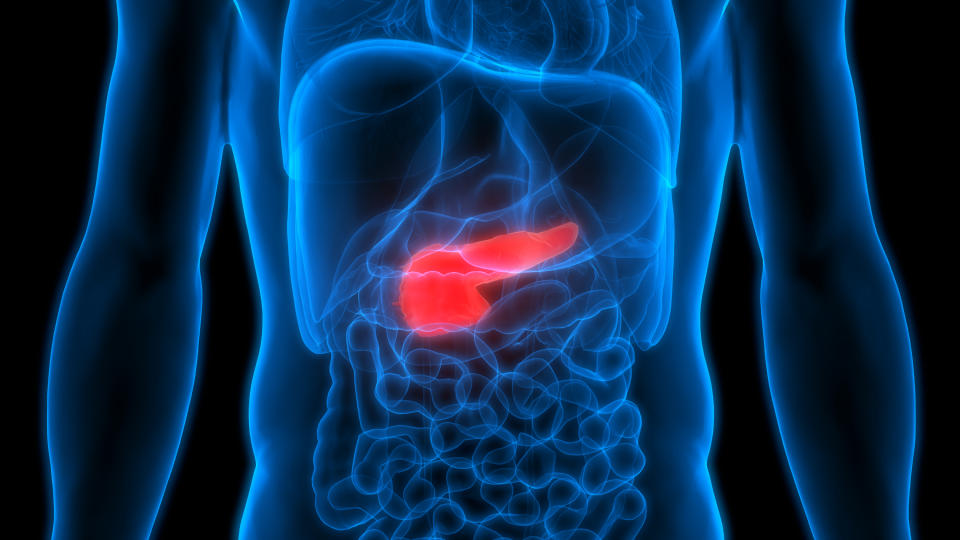Hopes of new pancreatic cancer drug after mice treated in surprise scientific discovery

Scientists have discovered a protein that they believe makes pancreatic cancer “so lethal”.
Pancreatic cancer is the tenth most common form of the disease in the UK, with 28 patients being diagnosed every day.
The survival rates are stark, with just 5% of cases still alive 10 years later.
A team from Sanford Burnham Prebys research institute in San Diego set out to uncover how pancreatic tumours would react if starved of oxygen, expecting them to thrive.
Read more: Teen has surgery to remove brain tumour on anniversary of his mother’s death
After turning off a gene that causes oxygen deprivation to these malignant cells in mice, the U.S. scientists were surprised to discover the disease became more aggressive.
When they dug deeper, the team found these rodents had higher levels of the protein PPP1R1B.
After removing the gene that codes for this protein, the mice improved, raising hopes PPP1R1B could be a new drug target.

Discovery ‘may help people fight the toughest cancer’
“Our study uncovers a protein, called PPP1R1B, that is completely new to pancreatic cancer researchers and that drives tumour metastasis, the major reason the cancer is so lethal,” said study author Dr Anindya Bagchi.
“With this proof-of-concept data, we can start drug screens that identify an inhibitor of PPP1R1B, which, if successful, may help more people survive pancreatic cancer.”
Pancreatic cancer is notoriously difficult to treat. Patients tend to be diagnosed in the later stages of the disease due to there being no screening programme and the symptoms generally being vague, like upper abdominal pain.
Read more: AI diagnoses prostate cancer with 98% accuracy
The pancreas is also situated near other vital organs, like the liver and intestines, raising the risk a tumour will spread.
If the disease stays within the pancreas, the five-year survival rate in the US is 37%.
The pancreas is considered a hostile environment, with cancer cells typically receiving little oxygen or nutrients.
While you may expect the tumour to perish, it often thrives despite these harsh conditions.
Cancer researchers have long speculated whether increased production of hypoxia inducible factor 1 alpha (HIF1A), a gene triggered by low oxygen levels, stimulates tumour growth.
To learn more, the Sanford scientists genetically engineered mice to have pancreatic tumours, but not produce HIF1A.
They thought removing this gene would allow the mice to become cancer-free, however, the rodents developed more aggressive tumours that invaded neighbouring tissues and eventually killed the animals.
“Our original hypothesis was if we remove HIF1A, a supposed driver of tumour survival, growth should be delayed or we should be curing the cancer,” said Dr Bagchi.
“Instead, we got the exact opposite results.
“When we saw this, we knew we may have hit something really interesting and needed to nail down exactly why we are seeing this effect.”
The scientists then discovered these mice had increased levels of PPP1R1B.
Read more: Blood test could diagnose cancer years before symptoms emerge
Results, published in the journal Gastroenterology, revealed that removing the gene that codes for this protein made the tumours spread less.
“Our data also showed tumour samples from people with metastatic pancreatic cancer had increased levels of PPP1R1B, adding further evidence the protein has therapeutic potential,” said co-lead author Dr Ashutosh Tiwari.
“Elevated levels of PPP1R1B have also been found in colon, lung and prostate cancers, and might also be seen in other hypoxic [low oxygen] tumours, so an inhibitor may have benefits beyond pancreatic cancer.”
The scientists plan to screen drugs to identify compounds that inhibit PPP1R1B.
“The path to a successful treatment for pancreatic cancer begins with a strong scientific understanding of what is driving the tumour's growth and aggressiveness,” said Dr Lynn Matrisian from the Pancreatic Cancer Action Network.
“This study has uncovered a promising drug target that, following additional research, may one day result in a treatment that helps more people fight the world’s toughest cancer.”

